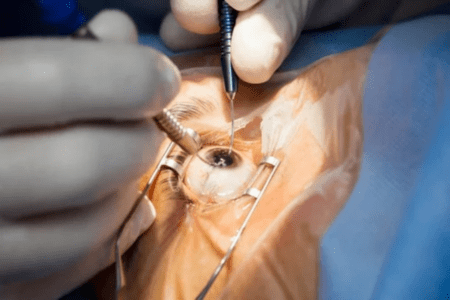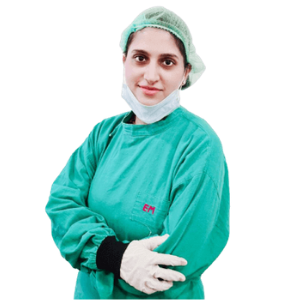Best Certified Laser Cataract Surgery In Delhi
100 % PAINLESS, STITCHLESS, and the entire way of performing the cataract surgery has been redesigned with this procedure of the best Bladefree Cataract Surgery in Delhi.
1. Up-to-date technology
2. 100% genuine Blade-Free procedure
3. Enhanced Visual results
4. Diminished risk of infection
Book Appointment

Cataract Surgery in Delhi
A cataract is essentially a condition in which the lens of the eyes gets clouded creating diminished vision. Cataracts occur because protein builds up in the lens of the eye and it is common among old-aged adults, however, it could occur in young adults and children as well. Cataracts cause the eyes to look foggy, clouded and milky in appearance.
This may result in facing difficulty in driving, reading, or remembering faces. To eliminate the problem of cataract the ophthalmologists suggest to go for cataract surgery. Cataract surgery by Eyemantra includes the elimination of the natural lens by a simple surgery.
Causes Of Cataract
- The most common cause of cataract is degenerative differences due to the ageing process. With age, proteins in the natural lens reduce, resulting in a clouded lens called a cataract.
- Health diseases like diabetes, kidney disease, glaucoma, smoking, eye injuries, infection, and swelling inside the eye.
- Prolonged use of some medications can also point to cataract development.
- A cataract may also happen in children due to genetic or metabolic defect or due to infection and trauma.
Symptoms Of Cataract
- Blurred vision
- Difficulty in seeing at night
- Viewing colors as faded
- Doubled sensitivity to glare
- Halos surrounding lights
- Double vision in the injured eye
- The requirement for various changes in prescription glasses
What Your Ophthalmologist Looks For?
Your ophthalmologist will suspect cataracts based on your age and medical histories like diabetes issue and your symptoms.
Diagnosis
Your doctor can do the diagnosis of cataracts by widening your pupil with medicine and monitoring your eye straight using an ophthalmoscope and a slit lamp. You may also be asked to have a visual acuity test, a test that applies an eye chart to examine the effect of the cataract on your vision.
Expected Duration
Cataracts are long-term difficulties. In most patients, their impact on vision develops with time.
Prevention
In general, there is currently no way to stop age-related cataracts. Though, people with diabetes may reduce their risk of developing cataracts by fully controlling their blood sugar levels. To help stop infection-related congenital cataracts, women must get checked with their doctors about their demand for rubella immunization before becoming pregnant. Women who are already pregnant should see their obstetricians frequently for fetal care.
Treatment
Cataract surgery is unusually an emergency. The decision to have surgery depends on the level to which your vision is impaired, balanced by the tiny risk that surgery entails. Although some persons with cataracts view that their vision differs. This happens by using eyeglasses, magnifying lenses, or stronger lighting, the only genuine alternative to cure cataracts are surgery. If cataracts impair both eyes, each eye surgery is scheduled and performed independently. Current surgical choices include Extracapsular cataract extraction and Intracapsular cataract extraction. Once the lens is eliminated, it may be substituted by one of 3 choices IOL implantation, contact lens, and special cataract glasses. Presently, around 90% or more of patients apply an IOL lens.
When To Call Your Doctor
Call your doctor whenever you have found difficulty seeing clearly. If you are older than 40, schedule an eye examination with your doctor every 2 years, even if you have not seen any change in your vision.
Prognosis
Cataract surgery improves the vision of 95 % of patients who have it. Of those patients who have IOL replacements, 90 % have 20/40 vision or better. In a few patients who have had extracapsular surgery, part of the lens capsule ultimately becomes cloudy, causing a condition called an after-cataract. This can be improved with laser surgery, usually as an outpatient.
Who Is At A Risk Of Cataract?
- Adults above the age of 50 as their eye muscles get weaker
- Individuals with poor lifestyle habits such as prolonged use of Steroids, Smoking or Alcohol abuse
- Environmental Factors such as over-exposure to harmful UV rays of the sun.
- People with diseases auto-immune diseases like Diabetes.
- People with Eye injuries.
- People with history eye diseases in the family.
- People with problems of Obesity.
- Individuals with Hypertension
Eligibility Criteria For Cataracts Surgery
One is an eligible candidate for cataract surgery if you are :
- Undergoing cloudy vision
- Observing bright colors as faded
- Experiencing double visions
- Feeling light sensitivity
- Undergoing poor night vision
- No Pregnancy and nursing
- Cataracts are hindering your daily activities such as driving, reading, cooking, or your outdoor activities
- Not undergoing dry eyes activity
Cataract Surgery Procedure
Cataract surgery is generally performed one eye at a time. Cataract surgery is an outpatient surgery most of the time which means it does not require an overnight stay at the hospital or health care facility. The Cataract eye surgery can be performed via two different procedures.
Traditional Surgery Procedure
- The scalpel blade is used to create an incision in the cornea by hand.
- Handheld Instrument is used to open up the sac/capsule holding the eye lens with cataract formation.
- The Cataract is then fragmented into smaller pieces.
- Fragmented Lens is then removed using suction.
- Artificial Lens is implanted to replace the previously natural cloudy lens and it is stitched up
Laser Cataract Surgery Procedure
- A device named LENSAR is used to break the cataract.
- Laser (Femtosecond Laser) creates corneal incisions to access the cataract.
- Cataract is removed using suction.
- Artificial Lens is implanted into the eye once the cataract is removed.
Zepto Cataract Surgery (STITCH-LESS)
- Zepto cataract surgery is another type of cataract removal procedure it is a procedure in which a handheld disposable device is used to create a strong, clear-cut, and precise incision in the crystalline lens of the eyes.
- Zepto surgery is in many ways much better, economical as well as less complicated than the femtosecond laser cataract operation.
Cataract Surgery Facts
- Early symptoms of cataracts involve blurred vision, glare and stress on eyes while reading.
- Cataracts will affect most people and become more noticeable age grows.
- Cataracts can be diagnosed when the doctor observes the eyes with specific viewing instruments.
- The choice to continue with cataract surgery is essentially based on the amount of problem you have while performing your regular activities.
- Treatment for cataracts is operational removal of the cataract with implantation of an artificial lens.
- Several kinds of intraocular lens types can restore vision in varying ways.
- Cataract surgery is a reliable and efficient way to restore vision with severe complications being unusual.
Types Of Cataracts
Cataracts are among the main causes of loss of vision among adults over the age of 45 and remain the principal cause of blindness across the world. It has been estimated that over 1.3 billion people are living with one form or the other of this disease.
There are various types of cataracts, some of them are:
- Subcapsular Cataract – Cataracts occur at the back of the eye lens.
- Nuclear Cataract – Occurs in the central zone of the eye’s lens. (also called the nucleus).
- Cortical Cataract – White Wedge-like opacity that starts at the edge of the eye lens but slowly works its way to the center (Nucleus).
- Growing Ages – Nearly half the population by the age of 60 develops cataracts and about 80% of people get a cataract in at least one eye by the age of 70 years.
- Traumatic Cataract – A direct injury or trauma can cause damage to the eye leading to a cataract. It can be progressive or instantly after a trauma.
- Metabolic Cataract – Various disorders in body metabolism including autoimmune diseases like diabetes and galactosemia can cause cataracts over time.
- Secondary Cataract – In several cases, cataract develops as a result of some other primary ocular disease such as chronic eye inflammation or glaucoma.
- Steroid-induced Cataract – Excess intake of oral steroids or inserting steroid drops in the eye can create cataracts. It is always recommended to ask a doctor before using one.
Traditional Vs. Laser Cataract Surgery In Delhi
| Basis | Traditional Cataract Surgery | Laser Cataract Surgery |
|---|---|---|
| Use of blade | Surgeon practices blade to create a hole in the eye for surgery. | No use of the blade in laser surgery as everything is through machines and computer. |
| Time taken in surgery | The procedure takes about 20-30 minutes per eye. | This procedure takes less than 5 minutes. |
| Blade-free | It’s not 100% blade-free surgery. | It is 100% blade-free, no pain and stitches during surgery. |
| Risk | It is slightly computer-controlled but have lots of risk factor. | Existence of an OPC is never dependent on the Nominee or Director. Can be dissolved by Regulatory Authorities. |
Catching Cataract Early
Cataracts start interfering with the day-to-day activities of the individual like reading, writing, driving among others hence, it becomes essential to address it as soon as possible. Basically, cataracts make it hard for light to pass through clearly and interferes with smooth vision. However, cataract is not a painful condition and it presents many symptoms before it starts showing drastic effects. Here are some symptoms that you have a cataract. You should immediately consult with an eye doctor if you start noticing any of these symptoms:
- Night Vision becomes blurry
- Sensitivity to Bright Lights
- Pale-yellow/ Clouded Vision
- Halos at light sources
- blurry vision and/or Double Vision
The symptoms of cataract are very subtle and it is also possible that you may not experience all of them at once. However, the cataract symptoms become noticeable slowly as the condition intensifies and it is necessary to consult with an eye care specialist as soon as these symptoms appear even the slightest bit.
Types Of Cataract Surgery
There are various technologies and basic techniques for cataract surgery like Phacoemulsification, MICS, Robotic Surgery, Extracapsular cataract surgery and Intracapsular cataract surgery.
Phacoemulsification
Phacoemulsification is the most common form of cataract removal and modern cataract surgery in which the eye’s inner lens is emulsified with an ultrasonic handpiece and extend from the eye. Aspirated fluids are reinstated with watering of balanced salt solution to keep the anterior chamber.
MICS
MICS is Micro Incision Cataract Surgery, the outcomes in cataract surgery depend on the size of incision and technology used. The visual results and recovery time are much better linked to conventional treatments as the incision size is even less.
Robotic Surgery
In (Bladeless Femto Laser Cataract Surgery) is the epitome of technology for cataract surgery. The treatment utilises computer programming and laser energy to perform the surgery.
Extracapsular Cataract Surgery
The procedure of extracapsular cataract surgery is usually applied to the person suffering from the most advanced cataract and the lens is very thick to dissolve into fragment or when phacoemulsification is impossible. Extracapsular cataract extraction normally needs an injection of numbing medication around the eye and an eye patch after the operation.
Intracapsular Cataract Surgery
The intracapsular cataract surgery surgical technique needs an even more open wound than extracapsular surgery, and the surgeon separates the entire lens mutually with the encompassing capsule. This technique needs the IOL to be inserted in a different location, in front of the iris.
Different Types Of IOL Lenses Implanted After Cataract Surgery
As the natural lens plays an important role in focusing light for clear vision, artificial lens implantation at the time of cataract surgery is required as a replacement for the natural lens to generate the best visual outcomes.
Monofocal Lens
Monofocal lens is the most applied lens during implantation. They have similar power in all ranges of the lens and can give high-quality distance vision, normally with only a light pair of spectacles needed for near vision. Monofocal lenses are in the finest focus at only one distance. They do not change preexisting astigmatism, a result of abnormal corneal shape that can change vision at all distances
Toric Lenses
The Toric lenses have more power in 1 specific axis in the lens to improve astigmatism with distance vision. Due to the variation in lens power in diverse areas, the change of astigmatism with a toric lens needs so that the lens be placed in a highly specific configuration. While toric lenses can correct distance vision and astigmatism, the patient still will need corrective lenses for all near tasks, such as account or writing.
Multifocal Intraocular Lens
Multifocal intraocular lens has a variety of sections with another power that enables some individuals to view at all the distances. While assuring, multifocal lenses are not for everyone. They can cause significantly more glare and loss of differences than monofocal or toric lenses.
Aspheric Lens
The Aspheric Lens assures a better quality vision and improved contrast sensitivity. It also provides better night vision and clarity under low light conditions.
What To Expect With Cataract Surgery
Before Cataract Surgery
Your surgeon will check your eye to see the proper focusing power for your IOL. You will also be asked not to take some of the medicines before surgery. You may be prescribed eye drop medications to begin before surgery. These medications assist in preventing infection and decrease swelling during and after surgery.
You should not eat a solid meal at least 6 hours before your surgery. The surgery for cataract removal can be done in a clinic or hospital with just a 15-20 minutes procedure.
During Cataract Surgery
Here is what will follow during the cataract surgery procedure:
- Your eye will be numbed with eye drops or with an injection.
- The surgeon applies these incisions to enter the lens in your eye.
- Surgeon will break up the lens with the cataract and eliminate and replace it with your new lens
- Usually, your surgeon will not require to stitch the incisions
- A shelter will be placed over your eye to preserve it while you recover from surgery.
Post Cataract Surgery
After the surgery, the surgeon might want to do a post-op evaluation and give instructions for recovery after the surgery:
- It is advisable not to drive right after the surgery and have someone accompany you for the surgery who can drive you back as well.
- Medicated eye drops will be administered to you and you will have to use them for a few weeks.
- Protective eye shields need to be worn as well
- It is advisable to avoid Heavy lifting, Bending, intensive exercises, swimming pools
Do’s & Don’ts After Cataract Surgery
| Do’s | Don’t |
|---|---|
| Wash your hands before you insert eye drops. Always shake the eye drop bottle before applying it and follow the directions to avoid any sort of infection or inflammation. | For women patients, it is prudent to stay away from eye makeup or every kind of toxic chemicals for a week after surgery. |
| Cataract Eye Surgery: Do’s Have a time gap in case of one or more eye drops and close the eye for 30-60 seconds directly for the drops to absorb well. | Avoid outdoor activities and crowded or dirty places as the eye are very delicate to catch infections. |
| Wear a protecting eye cover or eye patch while relaxing or sleeping to stop from accidentally rubbing the operated eye. | Aviod driving for few months as the stress on eyes are not good sign. |
| Use UV shielded sunglasses to guard your eye against straight sunlight and also the harmful rays of the sun. | Do not raise any heavyweights for a week after surgery and leave out any kind of sports or strenuous exercises for some time. |
| You can take a bath and wash your hair the next day but try not to get in touch of soap or water into the eye for at least 1 week. | Never rub your eye or use anything to your eyes even rose water. This will improve the chance of infection. |
| Have a healthy balanced diet for a few days after the surgery. | Just after the operation avoid bending as this is putting extra pressure on your eye. |
| Visit your ophthalmologist as per the schedules made by them for a check-up. In case of any problem, it is advisable to discuss the doctor as soon as possible. | Don’t swim or take a hot tub for at least 2 weeks after the surgery. Even a little drop of water makes your eyes exposed to infection. |
Our Team

Dr Shweta Jain
Cataract, Retina, LASIK

Dr Neha Wadhwa
Cataract, Retina, LASIK

Dr. Lalit Chaudhary
Femtosecond LASIK

Dr. Poonam Gupta
Femtosecond LASIK
Eyemantra- Famous For Cataract Surgery In Delhi
Eyemantra is the lead in Cataract treatment with over more than 1000 eyes operated. We are amongst the 1st few to have Femto Assisted Surgery Unit in Delhi. The surgery has exceptional precision and success rate without the application of blades. The technology enables correction of pre-existing astigmatism generated due to abnormal corneal curvature. This technology with a complete range of premium IOL gives the most beneficial of results after cataract surgery by our top cataract surgeons in Delhi and its NCR. Book an appointment with our best cataract eye doctor in Delhi to know more about cataract surgery cost in Delhi.
Eye Mantra Foundation believes in giving back to society and so to complete this mission, we have set up Charitable Eye Hospitals, which cater to the needs of people who have one or another form of eye ailment but do not have the means to afford the treatment.
- Our mission is to provide affordable eye care to everyone.
- Being an enthusiastic leader in the eye care sector, we have state of the art technologies for eye treatments.
- We have started this charitable hospital to make sure that even the poorest strata of society, has access to the best eye care treatment methods.
- We believe in giving back to the society and so for this particular purpose, EyeMantra provides it’s services to the poor sections of society at no cost.

Frequently Asked Questions
Who usually gets cataracts?
Cataracts normally affect patients over age 55, but, anyone can catch this problem. By the age of 65, 60% of people have formed a cataract and almost everyone over age 75 has at least one cataract. They occur due to the normal ageing process.
How much time is taken for performing a cataract surgery?
The cataract procedure itself only takes 15‐20 minutes.
When can start working on my normal activities?
Most normal activities can be continued within a day of surgery. In common, you should begin a normal life but avoid very difficult tasks or contact sports. Do not rub your eye and avoid swimming for 1 week after your surgery. Your ability to drive will depend on how fast your vision restores and the contrast among your eyes after the surgery.
Do I require glasses after cataract surgery?
This will depend on the kind of intraocular lenses (IOLs) used for you. The high-level intraocular lenses such as multifocal or accommodating IOLs exceedingly decrease dependency on glasses. In most cases even reading glasses can be avoided.
Will I feel pain throughout cataract surgery?
During cataract surgery, your surgeon will use give you a local anesthetic numbing eye drops to prevent you from experiencing pain throughout your procedure. You will also be provided with a mild sedative to assist you to relax. Depending on the patient and the kind of procedure, extra medication may be used. As the medications wear off, you may feel a scratchy sensation or slight soreness in your eye the first day. Over-the-counter pain relievers can be done to ease discomfort. If important, your doctor will guide stronger pain medication.
Is there any chance that cataract can happen again even after surgery?
No, a cataract can’t develop up again as the IOL implantation never requires maintenance and replacement. It very rare in few patients that a cloudy film is formed behind the implant on the lens capsule membrane, normally a few months later after the surgery. This condition is named as secondary cataract.
My doctor says I have a cataract problem, but he wants to wait a while before doing surgery it. Why?
Mild cataracts often create little or no vision problems. Your doctor is monitoring your cataract to see if it worsens and more significantly impairs your vision or lifestyle before suggesting surgery. Some cataracts don’t reach the level of surgery.
Is it possible that cataract surgery can be performed in both the eyes at the same time?
No, usually in cataract surgery 1 eye surgery is performed at once. The doctor cannot operate both the yes together. This enable the surgeon to judge the outcome of the 1st procedure before operating on the other eye. This evaluation may affect the decisions made for the second surgery, particularly in cases using an accommodative or multifocal lens.